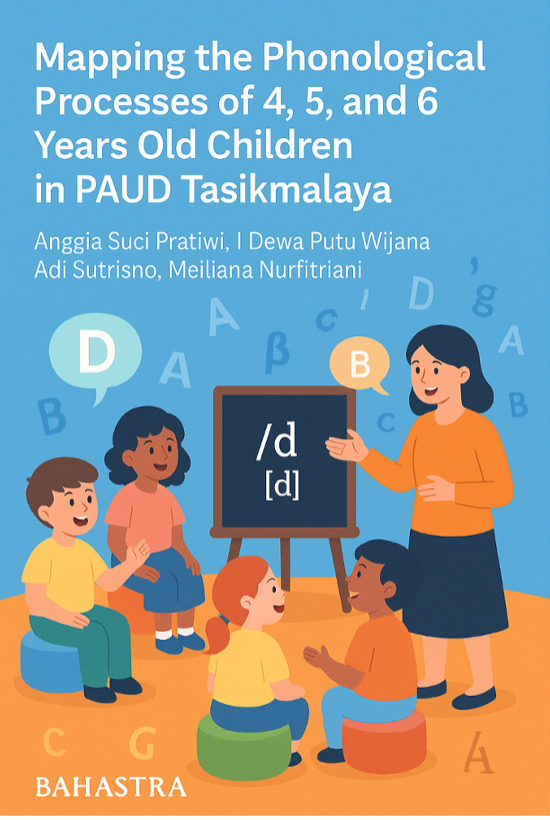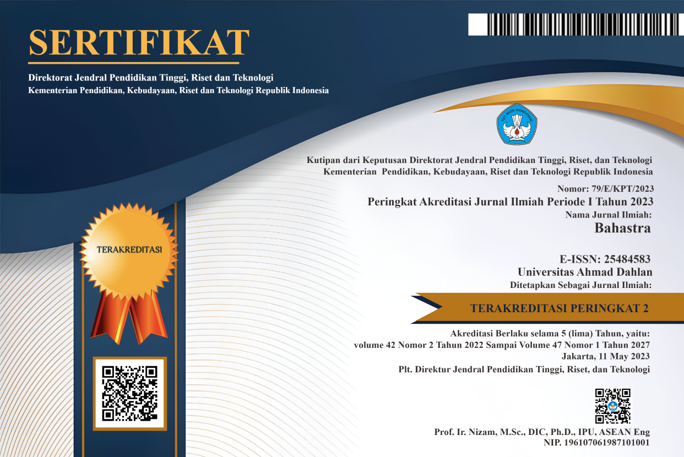Mapping the phonological processes of 4, 5, and 6 years old children in PAUD Tasikmalaya
DOI:
https://doi.org/10.26555/bs.v45i2.1518Keywords:
Early Childhood, Phonology, Phonological ProcessesAbstract
Phonological ability reflects the perceptual and cognitive mechanisms required for children to learn and produce speech. This study aims to map phonological processes in early childhood at PAUD institutions in Tasikmalaya. Using a qualitative descriptive approach, data were collected from 315 children aged 4–6 years (77 aged 4, 148 aged 5, and 90 aged 6) across five schools: RA Baiturrahman, TK Negeri Pembina, TK Cangkurileung Kartika IX-10, TK IT Ihya As-Sunah, and Joykids. Speech samples in Indonesian were obtained through recordings of both structured and conversational speech. Data validity was ensured through expert judgment, and analysis followed the stages of data reduction, display, and verification. Results show that assimilation was the most dominant phonological process for both vowels and consonants across all ages. For vowels, assimilation declined with age (9 cases at age 4, 7 at age 5, and 3 at age 6), while addition (4 → 2 → 2) and substitution (3 → 0 → 1) were less frequent. Consonant assimilation was more prevalent (62 → 71 → 27), with gliding substitution (13 → 5 → 0) and general substitution (4 → 2 → 0) steadily decreasing. Sound addition appeared only at age 6 (3 cases). These findings indicate that vowel mastery stabilizes earlier, while consonant mastery involves more complex developmental processes. The study provides baseline data for identifying phonological difficulties early and offers guidance for PAUD teachers to recognize ongoing phonological processes beyond age six as possible signs of language delay.
References
Anthony, J. L., & Francis, D. J. (2005). Development of phonological awareness. Current Directions in Psychological Science, 14(5), 254–259. DOI: 10.1111/j.0963-7214.2005.00376.x
Anthony, J. L., Aghara, R. G., Dunkelberger, M. J., Anthony, T. I., Williams, J. M., & Zhang, Z. (2011). What factors place children with speech sound disorders at risk for reading problems? American Journal of Speech-Language Pathology, 20, 146–160. DOI: 10.1044/1058-0360(2011/10-0053.
Barlow, J. A. (1996). Variability and phonological knowledge. In T. W. Powell (Ed.), Pathologies of Speech and Language: Contributions of Clinical Phonetics and Linguistics (pp. 125–133). New Orleans, LA: International Clinical Phonetics and Linguistics Association. DOI: 10.1044/jslhr.4206.1482.
Barlow, J. A., & Gierut, J. A. (1999). Optimality theory in phonological acquisition. Journal of Speech, Language, and Hearing Research, 42, 1482–1498. DOI: 10.1037/0012-1649.26.3.429
Bentral, E.J., Bankson, W.N., & Flipsen, P. Jr. (2016). Articulation and Phonological Disorders: Speech Sound Disorders in Children (8th ed.). Boston: Pearson.
Bryant, P. E., MacLean, M., Bradley, L. L., & Crossland, J. (1990). Rhyme and alliteration, phoneme detection, and learning to read. Developmental Psychology, 26, 429–438.
Chaer, A. (2011). Psycholinguistics: A Theoretical Study. Jakarta: Rineka Cipta.
Castles, A., & Coltheart, M. (2003). Is there a causal link from phonological awareness to success in learning to read? Cognition, 91, 77–111. DOI: 10.1016/S0010-0277(03)00164-1
Carrell, J., & Pendergast, K. (1954). An experimental study of the possible relationship between errors of speech and spelling. Journal of Speech and Hearing Disorders, 19, 327–334. DOI: 10.1044/jshd.1903.327
Carroll, J.M., et al. (2011). Developing Language and Literacy. Oxford: Wiley-Blackwell.
Chirlian, N.S., & Sharpley, C.F. (1982). Children's articulation development: Some regional differences. Australian Journal of Human Communication Disorders, 10, 23–30.
Chomsky, N., & Halle, M. (1968). The Sound Patterns of English. New York: Harper & Row.
Crystal, D. (2003). The Cambridge Encyclopedia of Language (2nd ed.). Cambridge University Press.
Dardjowidjojo, S. (2018). Psycholinguistics: An Introduction to Understanding Human Language. Jakarta: Yayasan Pustaka Obor Indonesia.
Dardjowidjojo, S. (2018). Echa: The Story of Indonesian Children's Language Acquisition. Jakarta: Grasindo.
Dixon, P. D., LeFevre, J., & Twilley, L. C. (1988). Word knowledge and working memory as predictors of reading skill. Journal of Educational Psychology, 80(4), 465–472. DOI: 10.1037/0022-0663.80.4.465.
Ellis, R. (1990). Instructed Second Language Acquisition. Cambridge: Basil Blackwell, Inc.
Ferguson, C. A., & Farwell, C. B. (1975). Words and sounds in early language acquisition. Language, 51(2), 419–439.
Fletcher, P. dan M.Garman. (1979) Language Acquisition: Studies in First Language Development. Cambridge: Cambridge Unversity Press, 1979.
Fikkert, P. (2007). Acquiring phonology. In P. de Lacy (Ed.), The Cambridge Handbook of Phonology (pp. 537–554). Cambridge University Press.
Gathercole, S. E., Willis, C., & Baddeley, A. D. (1991). Differentiating phonological and awareness of rhyme: Reading and vocabulary development in children. British Journal of Psychology, 82, 387–406. DOI: 10.1111/j.2044-8295.1991.tb02406.x
Haryanti, E., Ari, DL, & Teti, S. Language acquisition of 2–3 year old children viewed from the phonological aspect. Parole: Journal of Indonesian Language and Literature Education, 1(4).
Hassink, J. M., & Wendt, O. (2010). Remediation of phonological disorders in preschool age children: Evidence for the Cycles Approach. EBP Briefs, 5(2), 1–7.
Hoff, E. (2013). Language Development (5th ed.). Belmont, CA: Wadsworth.
Ingram (1979). Phonological Disability in Children. London: Edward Arnold.
Jakobson, R. (1980). Child Language, Aphasia, and Phonological Universals. New York: Mouton Publishers.
Jakobson, R. (1995). OnLanguage. Cambridge: Harvard University Press.
Johnston, R. S. (1995). The functions of phonology in the acquisition of reading: Lexical and sentence processing. Memory & Cognition, 23(6), 749–766. DOI: 10.3758/BF03200904
Lonigan, C.J., et al. (2009). The nature of preschool phonological processing abilities and their relationships to vocabulary, general cognitive abilities, and print knowledge. Journal of Educational Psychology, 345–358. DOI: 10.1037/0012-1649.36.5.596
Kapoh, RJ (2010). Some factors that influence language acquisition. Interlingua Journal, 4, 87–95.
Kover, T. S. (2018). Distributional cues to language learning in children with intellectual disabilities. Language, Speech, and Hearing Services in Schools, 49(3s).
Kuhl, P. K. (2004). Early language acquisition: Cracking the speech code. Nature Reviews Neuroscience, 5(11), 831–843.
Maharany, AF (2016). Phonological symptoms of Indonesian language in children aged 3-4 years at Permata Hati PAUD, Kendari City. Bastra Journal, 1(2).
McLeod, S., & Bleile, K. (2004). Neurological and developmental foundations of speech acquisition. American Journal of Speech-Language Pathology, 13(3), 172–191.
Miles, MB, & Huberman, AM (1984). Qualitative Data Processing (Translated by Tjetjep Rohendi Rohidi). Semarang: Semarang State University.
Preston, J., & Edwards, M. L. (2010). Phonological awareness and types of sound errors in preschoolers with speech sound disorders. Journal of Speech, Language, and Hearing Research, 53(1), 44–60.
Rhyner, P. M. (2009). Emergent Literacy and Language Development: Promoting Learning in Early Childhood. New York: The Guilford Press.
Snowling, M., & Hulme, C. (2014). The development of phonological skills. Philosophical Transactions: Biological Sciences, 346(1315). DOI: 10.1098/rstb.2012.0397
Simanjuntak, M. (1990). Theories of Phonological Acquisition. Jakarta: Gaya Media Pratama.
Sumargi, AG (2002). The cognitive model and intervention for specific reading disorders. Anima, Indonesian Psychological Journal, 17(4), 311–317.
Supratiknya, A. (2011). Designing Psychoeducational Programs and Modules (revised edition). Yogyakarta: Sanata Dharma University.
Yanti, PG (2016). Children's language acquisition: A study of phonological aspects in children aged 2–2.5 years. VISI PPTK PAUDNI Scientific Journal, 11(2).
Vihman, M. M. (2014). Phonological Development: The First Two Years. Wiley-Blackwell.
Zubaidah, E. (2004). Early childhood language development and its development techniques in schools. Jurnal Cakrawala Pendidikan, 3.

Downloads
Published
Issue
Section
License
Copyright (c) 2025 Anggia Suci Pratiwi, I Dewa Putu Wijana, Adi Sutrisno, Meiliana Nurfitriani

This work is licensed under a Creative Commons Attribution-ShareAlike 4.0 International License.

1.jpg)






